Infective Endocarditis
Michael H. Crawford, MD
 ESSENTIALS OF DIAGNOSIS
ESSENTIALS OF DIAGNOSIS
![]() Fever.
Fever.
![]() Blood cultures positive for bacteria or fungi.
Blood cultures positive for bacteria or fungi.
![]() Characteristic cardiac lesions on echocardiography.
Characteristic cardiac lesions on echocardiography.
 General Considerations
General Considerations
Infective endocarditis is one of several infections in which endothelium is the initial site of infection. Healthy endothelium possesses an effective system of defense against both hemostasis and infection. Infection of the endothelium of blood vessels occurs only at sites markedly altered by disease or surgery, such as the severely atherosclerotic aorta or the suture lines of vascular grafts. By contrast, infection of the cardiac valve leaflet endothelium (endocardium) is not rare and occurs even in the absence of identifiable preexisting valve disease.
 Pathophysiology & Etiology
Pathophysiology & Etiology
A. Cardiac Infection—Vegetations
1. Precursor lesion and bacteremia—Valve infection probably begins when minor trauma, with or without accompanying valve disease, impairs the antihemostatic function of valve endocardium. Infection usually first appears along the coapting surface of the leaflets, suggesting a role for valve opening and closing. This hypothesis is supported by the observation that the ranking of valves in order of frequency of infection corresponds to the ranking of valves according to the force acting to close the valve (mitral aortic > tricuspid > pulmonic).
This minor trauma may cause the formation of a microscopic thrombus on the leaflet surface. A small noninfected thrombus on the leaflet is called nonbacterial thrombotic endocarditis (NBTE). The next step is infection of the fibrin matrix of the thrombus by blood-borne organisms, which appear briefly in blood under many circumstances, such as brushing one’s teeth. When transient bacteremia coincides with the presence of an NBTE lesion, organisms may adhere to the valve leaflet and begin to proliferate.
This theory for the pathogenesis of endocarditis is supported by observations regarding the circumstances under which endocarditis occurs and the particular organisms involved. Patients with endocarditis often tell of a preceding event that likely resulted in transient bacteremia. The common infecting organisms are those that gain entry to the blood because they colonize body surfaces and are adapted for attachment and proliferation in the NBTE lesion (see Clinical Syndromes).
2. Growth of vegetations—Vegetations begin near the coaptation line of the leaflet on the side that contacts the opposite leaflet during valve closure. Mitral valve vegetations are typically attached within 1–2 cm of the leaflet tip on the left atrial side and prolapse into the left atrium during systole. Aortic valve vegetations usually occur on the left ventricular (LV) side of the mid or distal portions of the aortic cusps and prolapse into the LV outflow tract during diastole. A similar distribution of lesions occurs on the tricuspid and pulmonic valves.
Although the course of cardiac lesions in endocarditis varies, in a typical sequence of events (without treatment), the infection progresses by enlargement of the vegetation and extension of its region of attachment toward the base of the leaflet. Valve regurgitation almost always develops, as a result of either destruction of the leaflet tip or scarring and retraction of the leaflet. Erosion of the leaflet may lead to perforation (usually associated with clinically significant regurgitation). Weakening of the leaflet’s spongiosum layer may result in a deformity called a leaflet aneurysm. Mitral or tricuspid chordal involvement may cause rupture and acute severe regurgitation. In rare cases (primarily in mitral bioprosthetic endocarditis; see Management of High-Risk
Endocarditis), a large vegetation may cause hemodynamically significant valve obstruction.
3. Metastatic vegetations—These vegetations may form when the regurgitant jet of blood from an infected valve strikes an endocardial surface in the receiving chamber (wall or chordae), producing a small area of denuded endothelium. The thrombus that forms at this site also becomes infected, constituting a secondary vegetation. Such meta-static vegetations most often appear on the ventricular side of the anterior mitral leaflet where it is struck by a regurgitant jet from aortic valve endocarditis. Another common location is on the mitral chordae, also from aortic regurgitation. Metastatic lesions on the mural endocardium of the cardiac chambers can occur as well.
4. Abscess and fistula formation—Organisms eventually invade the valve annulus and adjacent myocardium. Abscess formation can take multiple forms and may occur with or without fistula formation. Aortic annular abscess is an infective mass that burrows into or around the outside of the annulus. The abscess may extend upward to the sinus of Valsalva or ascending aorta (a type of mycotic aneurysm). This extension may lead to a fistulous communication between the aorta and the left atrium or (rarely) the right atrium. In other patients, the abscess extends down through the fibrous trigone and forms a fistula to the LV outflow tract.
A band of fibrous tissue at the base of the anterior mitral leaflet (the intervalvular fibrosa) separates the aortic annulus from the left atrial wall. Infection extending down from the posterior aortic annulus may produce an aneurysm in this area, which may in turn fistulize to the left atrium, aortic root, or into the pericardial space. Infection extending down from the anterior aortic annulus may invade the septal myocardium, causing a block in the conduction system.
When mitral valve infection extends to the base of the anterior leaflet, abscess formation involving the fibrous trigone may track upward and become fistulous. Infection from the posterior leaflet may extend to form a myocar-dial abscess in the LV posterior wall or a fistula around or through the mitral annulus between the left atrium and left ventricle. Infection may even penetrate through to the pericardial space, producing purulent pericarditis.
B. Extracardiac Disease
At any time during cardiac infection, extracardiac complications may supervene and dominate the clinical picture. Although these manifestations are emphasized in the medical literature, it should be kept in mind that many patients with endocarditis do not have them, especially at the time of presentation. The extracardiac disease in endocarditis results from immunologic phenomena and the shedding of bacteria and fragments of infected thrombus from the valve vegetations.
1. Immune disease—The bacteremia accompanying endocarditis persists over long periods of time and represents a prolonged antigenic challenge to the immune system. Various antibodies and immune complexes appear in the blood—more so with longer duration of illness. Rheumatoid factors (anti-IgG or IgM antibody) are rarely of interest for their diagnostic value. Other antibodies, such as those that form circulating immune complexes and activate complement, are of major importance because they cause micro-vascular damage, most frequently glomerulonephritis and vasculitic skin lesions.
2. Systemic and pulmonary emboli—The embolization of fragments of vegetation is a frequent and potentially catastrophic complication of endocarditis. The clinical consequences are highly variable and depend on many factors, including the size of the embolus, the site at which it lodges in the vasculature, the type and quantity of organisms carried, the point during treatment at which embolism occurs, and the host response. Small emboli are likely to present as metastatic infection; the most dreaded of these is brain abscess. Septic embolization may also lead to abscesses in the kidney, liver, bone, and (from the right heart) lung.
Large emboli present with signs and symptoms of major vascular obstruction. For endocarditis of the left heart, the most frequent and serious extracardiac complication is embolism to the brain; these strokes tend to be large, complicating subsequent management and often causing death. Emboli may also cause infarction of the spleen, liver, kidney, and the myocardium. Embolism to large arteries of the extremities is unusual and occurs primarily in fungal endocarditis.
3. Mycotic aneurysms—When infection of the arterial wall results in localized dilatation and progresses to abscess formation, mycotic aneurysms can occur. The cause is thought to be embolization of vegetation that does not obstruct blood flow enough to present clinically as embolism. These lesions frequently occur at vessel branch points. The mycotic aneurysm may produce signs and symptoms many weeks after the diagnosis of endocarditis, and recognition may be difficult. Their effects are especially devastating in the central nervous system. Aneurysms may act as a protected site of infection and cause persistent fever or bacteremia despite appropriate antibiotic therapy. Alternatively, if antibiotic therapy has sterilized the aneurysm, it may present months or years later as unexplained hemorrhage.
C. Clinical Syndromes
Endocarditis can assume any of a wide variety of forms because of the many possible combinations of infecting organisms, portals of entry, and other factors such as the patient’s immune status and the presence of concomitant diseases. Although the list of organisms capable of causing endocarditis is very long (and the list of possible combinations of organisms and other factors is even longer), there are several common and distinctive clinical syndromes.
Table 22–1. Characteristics of Acute and Subacute Endocarditis1
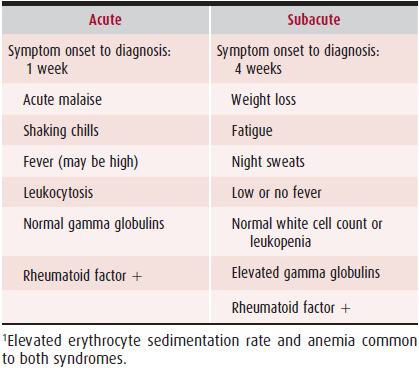
A distinction between the acute and subacute forms of endocarditis has been found to be of some clinical value. The differing characteristics of patients with these two forms are shown in Table 22–1. Many patients with endocarditis cannot be easily placed into one or the other of these two categories.
1. Viridans streptococcal endocarditis—The bacterial species classified as viridans streptococci account for approximately 25% of cases of endocarditis. These organisms can be divided into three groups: normal human oral flora (Streptococcus mitis, Streptococcus sanguinis, Streptococcus anginosus, Streptococcus mutans, Streptococcus salivarius, and other nutritionally variant species), inhabitants of the lower gastrointestinal and genitourinary tracts (nonenterococcal group D organisms, of which Streptococcus bovis is important), and Streptococcus pneumoniae, or pneumococcus, which infrequently causes endocarditis and causes a syndrome very different from the other viridans streptococci. The first two groups of streptococci cause almost no other disease in humans, except for endocarditis. This predilection appears to stem from bacterial cell wall proteins that bind to fibronectin, platelets, laminin, and other components of blood clots.
Viridans streptococci usually grow slowly, and the patient typically has a febrile illness of at least 10 days’ duration and modest intensity; many cases fit the clinical syndrome of subacute bacterial endocarditis. Although valve destruction may be extensive, it is gradual, and abscess formation in the heart or elsewhere is uncommon. Infection of a normal valve by viridans streptococci is probably unusual. The renal disease accompanying endocarditis caused by these organisms is usually mild and rarely causes significant renal insufficiency. Viridans streptococcal endocarditis is therefore often treatable medically and has a relatively good prognosis if antibiotic treatment is begun before complications occur.
Endocarditis from S bovis is strongly associated with underlying colorectal disease, especially malignancy. Colonization of the gastrointestinal tract by this organism increases with age and with malignancy for reasons that are not well understood. After initial endocarditis treatment, a patient with this disease should undergo colonoscopy.
Extra vigilance for complications is needed when treating patients with endocarditis from certain other streptococci. Streptococcus anginosus and Streptococcus milleri tend to cause abscesses in the brain and other major organs, and nutritionally variant streptococci are associated with higher morbidity and mortality rates than are the other viridans organisms—again for reasons that are not understood.
Complications from viridans streptococcal endocarditis are almost never due to failure to sterilize vegetations. Nevertheless, the sensitivity of these organisms to penicillin is not uniform, and testing for resistance is essential for establishing an appropriate antibiotic regimen.
2. Staphylococcus aureus endocarditis—S aureus is a relatively common cause of endocarditis, accounting for approximately 33% of all cases. In hospitals serving a large population of injecting drug users, this may be the most common cause of endocarditis. Although S aureus frequently enters the circulation from the skin or nares, a culprit lesion may not be apparent on examination of these areas. Less than 25% of episodes of S aureus bacteremia in hospitalized patients are caused by endocarditis.
Unlike patients with streptococcal endocarditis, those with endocarditis caused by S aureus are likely to seek medical attention soon after the onset of bacteremia, which generally produces a febrile illness with marked constitutional symptoms and often rigors. This picture is especially common in injecting drug users. S aureus tends to cause valve destruction more rapidly than do other organisms; approximately 30% of cases result in extensive left-heart valve involvement complicated by abscess or fistula formation or pericarditis. S aureus endocarditis of the aortic valve is the most common cause of aortic annular abscess, often signaled by the appearance of PR interval prolongation. Mitral annular and myocardial abscesses are also associated with this organism.
Central nervous system involvement is present in 20% or more of cases and manifests as cerebral embolization, intracranial hemorrhage from mycotic aneurysm rupture, and microscopic or macroscopic brain abscesses. Other significant complications include septic arthritis, osteomyelitis, and major organ abscesses. Renal involvement, as indicated by an active urine sediment, is present in almost all cases, and frank renal impairment occurs in approximately 20%. The renal dysfunction caused by S aureus rarely progresses to dialysis or permanent renal failure.
S aureus is the most lethal of the organisms commonly causing endocarditis, with mortality rates of approximately 30% in non–injecting drug users and greater than 50% in patients with prosthetic valves. Injecting drug users have a much lower mortality rate (approximately 5%).
3. Enterococcal endocarditis—This form accounts for approximately 5% of cases of endocarditis—almost all from Enterococcus faecalis. Enterococcal endocarditis tends to occur in elderly men undergoing diagnostic manipulation or surgery involving areas colonized by this organism, such as the gastrointestinal and genitourinary tracts; in injecting drug users; or in women following obstetric procedures. An acute or insidious syndrome may be present in patients with enterococcal endocarditis, although the findings typical of subacute bacterial endocarditis are unusual.
Enterococcal endocarditis is especially difficult to treat because of antibiotic resistance (discussed later). It is markedly different from and far more serious than streptococcal endocarditis. Overall mortality is only slightly less than that for staphylococcal endocarditis, and the incidence of major complications and need for valve replacement is approximately 30–40%.
4. Endocarditis from gram-negative bacteria—Gram-negative bacteria rarely cause endocarditis, with the exception of three groups of organisms: Pseudomonas aeruginosa, the HACEK organisms (Haemophilus spp., Actinobacillus, Cardiobacterium, Eikenella, Kingella), and the enteric organisms (Escherichia coli, Proteus, Klebsiella, and Serratia marc-escens). Pseudomonas and Serratia are occasional causes of endocarditis in injecting drug users.
The HACEK organisms are relatively slow growing and usually cause a subacute clinical syndrome. Organisms such as Haemophilus and Cardiobacterium are thought to account for cases of culture-negative endocarditis. Despite the often mild symptoms and signs of endocarditis caused by these organisms, valve destruction may be extensive by the time of diagnosis. The HACEK organisms are associated with endocarditis that causes major vessel embolism from large vegetations. Enteric organisms tend to produce an acute clinical syndrome similar to that caused by Pseudomonas.
5. Fungal endocarditis—Fungal endocarditis is associated with settings of immune compromise and procedures that give the organism access to the bloodstream, such as surgery, intravenous catheter placement, and injecting drug use. Candida species (especially C albicans), Histoplasma capsulatum, and Aspergillus account for approximately 80% of cases of fungal endocarditis. Other less common causative organisms include Mucor and Cryptococcus. Clinicians must recognize when patients are at risk for fungal endocarditis because the signs and symptoms of the disease often escape notice or lead to misdiagnosis. Risk factors are listed in Table 22–2. In most patients with fungal endocarditis of a native valve, the infection is related to a fundamental immune system impairment. Fungal superinfection should be considered when a patient with bacterial endocarditis relapses either late in the antibiotic course or after completing treatment. This observation is especially true for bacterial infection of a prosthetic valve. Candida species infection is usually hospital-acquired, whereas histoplasmosis may be a community-acquired infection. Fungal endocarditis in injecting drug users is almost always due to non-albicans species of Candida.
Table 22–2. Risk Factors for Fungal Endocarditis
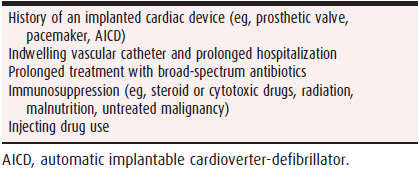
The clinical syndrome of fungal endocarditis is more difficult to recognize than that of bacterial endocarditis. This may be due partly to the postsurgical state or multisystem disease common in these patients. It has also been suggested that fever and murmurs develop later in the course of fungal disease than in bacterial endocarditis and that leukocytosis and such peripheral manifestations as petechiae are less frequent. The development of symptoms is often insidious, extending over weeks or months. Cardiac involvement is generally limited to the development of vegetations; invasion of the myocardium occurs with a lower frequency than in bacterial endocarditis. The vegetations usually lead to leaflet destruction and valve regurgitation; they may be large and may occasionally cause valve orifice obstruction. The most likely complication of fungal infective endocarditis is embolism, including occlusion of large peripheral arteries from embolization. Table 22–3 lists the approximate frequency of causative organisms in native valve endocarditis.
Table 22–3. Native Valve Endocarditis: Causative Organisms
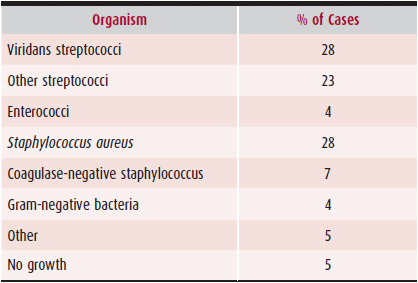
6. Prosthetic valve endocarditis—The risk of developing endocarditis is higher with prosthetic heart valves than with severely diseased native valves, approximately 0.5% per patient-year. Despite some overlap, there is a clear difference between the causes of disease that develops within 2 months of implantation and the causes of disease that occurs later (Table 22–4). The difference is probably due to infection occurring during surgery in early prosthetic endocarditis, with organisms from the skin of the patient and operating room personnel (Staphylococcus epidermidis and S aureus) accounting for more than half the cases. The incidence of early prosthetic endocarditis has been greatly reduced by the routine use of prophylactic antibiotics for several days after operation. Prosthetic infection after 2 months usually involves the same mechanism as does native valve endocarditis, except that the causative organisms are those adapted to nonbiologic material.
Table 22–4. Prosthetic Valve Endocarditis: Causative Organisms
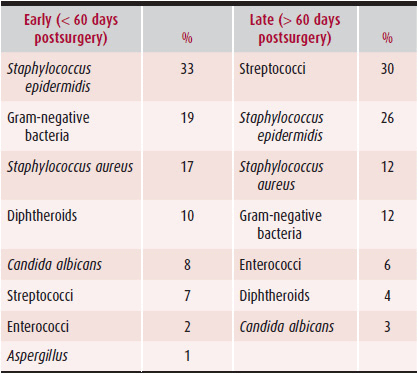
Infection of a bioprosthesis involves primarily the sewing ring. Vegetations similar to those of native valve endocarditis can occur when the prosthesis is biologic, but infection more often begins in the area of attachment of the sewing ring to the annulus. Vegetations may form in this area, but—most important—early in the disease, abscesses often form along the suture line, resulting in fistulization, paravalvular regurgitation, and partial or complete detachment (dehiscence) of the prosthesis.
Infection of a mechanical prosthesis centers on the sewing ring. The inward growth of an infective mass from the ring frequently causes the occluder to become stuck in a partially open or closed position. The lesions caused by sewing ring infection of mechanical prostheses are otherwise similar to those of bioprostheses.
Two important differences distinguish prosthetic valve endocarditis from native valve infection. Prosthetic valve infection may be extensive without the clinical signs, such as a murmur of regurgitation, heart failure, or embolism, usually seen in advanced native valve infection. When prosthetic valve dysfunction does occur (especially in a mechanical prosthesis), it tends to be abrupt and severe, as when the occluder becomes fixed in a half-open position. (Other differences are discussed later in this chapter.)
7. Endocarditis in the injection drug user—The patient usually has an intense febrile illness of several days’ duration, starting within 24–48 hours of the last injection. The mode of infection is a needle contaminated by skin flora, and an intravenous injection site may show an abscess or thrombophlebitis. The most likely causative organism is S aureus, which, overall, causes 70% of endocarditis in injecting drug users and which, in this setting, has a benign prognosis with only a 2–5% mortality rate. Many other organisms can cause endocarditis in injection drug users, including gram-negative bacilli, especially P aeruginosa, C albicans, enterococci, and S marcescens, as well as viridans streptococci. The prevalence of specific causative organisms varies widely in different urban areas. Endocarditis from these organisms tends to be less acute than that caused by S aureus, but only rarely is it truly subacute.
Infection of the tricuspid valve is almost unique to injecting drug users and occurs in approximately 60% of cases of endocarditis in this population. Significant tricuspid regurgitation may not be clinically apparent. In as many as 40% of cases, the left heart valves alone are infected. Despite its proximity to the portal of entry in injecting drug users, the pulmonic valve is rarely involved, probably because of the low pressure gradient and low wear and tear of this valve. Chest pain and dyspnea should prompt consideration of septic pulmonary emboli, which occur in 30% of tricuspid valve endocarditis. This complication usually presents as chest pain accompanied by scattered fluffy pulmonary infiltrates. On serial chest films, these lesions may appear migratory because of simultaneous resolution of older infiltrates and appearance of new ones. Infiltrates may also progress to cavitation.
8. Endocarditis and human immunodeficiency virus (HIV)—HIV infection and acquired immunodeficiency syndrome (AIDS) do not increase the risk of infective endocarditis. The increased frequency of endocarditis in patients with HIV is due to the prevalence of injecting drug use in this population. HIV/AIDS patients appear to have an increased susceptibility to Salmonella endocarditis, a relatively antibiotic-responsive infection. Otherwise, the types of causative organisms seen are not altered by HIV status. The clinical syndrome and natural history of the disease in HIV-positive patients is also unchanged, except that patients with advanced AIDS (CD4 count < 200 cells/mcL) tend to have a more fulminant course and increased mortality rates.
9. Hospital-acquired endocarditis— Hospital-acquired endocarditis is uncommon; overall approximately 5% of positive blood cultures in hospitalized patients are due to infective endocarditis (exceptions include streptococcal viridans and nutritionally variant streptococci). Prosthetic valves are at far greater risk than native valves: endocarditis develops in 15–20% of patients with prosthetic valves who become bacteremic. Hospital-acquired endocarditis is marked by an increased likelihood of the presence of unusual or antibiotic-resistant organisms and an infected indwelling catheter as the likely portal of entry. Endocarditis occurs only rarely in postsurgical patients, usually after prolonged sepsis.
The usual causative organisms are coagulase-negative Staphylococcus; S aureus; Enterococcus; and enteric gram-negative organisms, such as Pseudomonas and Serratia. Fungi, especially Candida, and fastidious organisms should also be suspected when endocarditis occurs in debilitated, leukopenic patients and those previously treated with long courses of antibiotics. Hospital-acquired endocarditis should be suspected when fever develops in a hospitalized patient who has positive blood cultures without an apparent source. Potential culprit catheters should be removed and cultured, followed by transesophageal echocardiography (TEE) if an additional risk factor for endocarditis exists. Examples of risk factors in this setting include a prosthetic valve, native valve disease predisposing to infection, or S aureus bacteremia. If the findings of TEE are normal, and other sources of infection have been ruled out, a short (2-week) course of antibiotics is usually appropriate. Surveillance blood cultures during and after treatment and a repeat TEE should be considered if uncertainty regarding the response to treatment persists. In the case of exposure of a prosthetic valve to bacteremia, blood culture surveillance should be extended for at least 2 months.
10. Pacemaker or implanted defibrillator endocarditis—Pacemaker endocarditis is infection of the lead or of parts of the heart in contact with the lead (tricuspid valve, right ventricular endocardium). Mortality is high, up to 25%, and the diagnosis is often missed due to the indolent nature of the infection. Most cases are due to contamination at the time of implant; hematogenous infection of a lead is rare. Most cases have evidence of present or prior infection at the implant site. The delay from the most recent pacemaker procedure to the diagnosis of endocarditis may be as long as 2 years or as little as 6 weeks. In addition to fever and positive blood cultures, infection causes septic pulmonary emboli in about one-third of cases. Transesophageal echocardiography is the diagnostic test of choice, with a sensitivity of over 90%. The findings on transthoracic echocardiography (TTE) are often falsely normal.
Staphylococci are the usual infecting organisms, with S epidermidis accounting for 70% of cases and S aureus for most of the rest. As with prosthetic valve endocarditis, S aureus is the most likely culprit when endocarditis develops soon after implant, whereas S epidermidis is more likely when endocarditis develops later. Staphylococcus species produce a slime-like “sleeve” along the lead that protects bacteria from the patient’s immunologic defense as well as from antibiotic therapy. Treatment requires removal of the lead, and usually the entire system. Lead removal can be accomplished percutaneously with reasonable safety if the masses attached to the lead are small (< 1 cm). Surgery is indicated if the lead is fixed, if a large mass (> 1 cm) is present (with dislodgement likely to result in severe pulmonary embolism), or if tricuspid valve involvement is extensive. Lead removal is followed by 6 weeks of antibiotic therapy. The pacemaker-dependent patient is given an epicardial lead; reimplant of a transvenous system can be considered after 2 months with negative surveillance blood cultures.
 Clinical Findings
Clinical Findings
A. Diagnostic Criteria
In the current era, with the availability of sensitive blood culture techniques and TEE, the clinician will rarely need to rely on a formal schema for the diagnosis of endocarditis. The most useful schema is the Duke criteria, which involve two “major” criteria (definite echocardiographic evidence of endocarditis, positive blood cultures) and six “minor” criteria (predisposing cardiac condition, fever, vascular phenomena, immunologic phenomena, suggestive echocardiogram, ambiguous blood cultures) to reach a probable diagnosis. This approach was useful because of the low sensitivity and specificity of clinical features by themselves. Now TEE and blood cultures independently have a diagnostic sensitivity of greater than 90%, and TEE has a specificity of greater than 90%. Diagnostic uncertainty may arise when the result of TEE is ambiguous or when adequate blood cultures are not obtained before starting antibiotics. In many such situations, a diagnosis can be reached by gathering more data. For example, if the TEE fails to show endocarditis-specific valve disease and the patient is doing well, discontinuing antibiotics in order to repeat cultures should be considered. Many of the common features of endocarditis—fever, a cardiac murmur, and a set of positive blood cultures—occur frequently in other diseases and are occasionally absent in patients with endocarditis. Other diseases frequently mimicked by endocarditis include malignancy, autoimmune disease, and septicemia. In addition, patients with endocarditis may come to the physician because of a complication of endocarditis so dramatic as to distract attention from the underlying infection. Typical settings in which this error occurs include heart failure, stroke, and myocardial infarction.
The recognition of possible prosthetic valve endocarditis may be difficult because the signs of infection may be very subtle. In early prosthetic endocarditis, the symptoms and signs may be incorrectly ascribed to other diseases. Fever and bacteremia during the first few weeks after prosthetic implantation should be considered to indicate prosthetic valve endocarditis until proven otherwise. This is especially important because early prosthetic valve endocarditis appears to follow a more fulminant course than either late prosthetic or native valve endocarditis. These patients often have other potential causes of bacteremia, however, and an effort to prove infection from another site should be pursued vigorously. Transesophageal echocardiography probably has a sensitivity of approximately 80% for prosthetic valve endocarditis and should be performed whenever an alternative explanation for fever or bacteremia is not readily apparent. If the TEE findings are normal but bacteremia persists (especially if the organism is a frequent cause of prosthetic endocarditis), prosthetic infection should be presumptively treated. Fluoroscopy to rule out dehiscence has been replaced by TEE.
Fungal endocarditis is also often difficult to diagnose. Blood cultures are negative in approximately half of cases caused by C albicans, the majority of histoplasmosis cases, and almost all cases caused by Aspergillus. Histologic examination and culture should be performed whenever possible on specimens of embolic material, oropharyngeal lesions (especially for histoplasmosis), skin lesions (for Candida species and Aspergillus), liver, bone marrow, and urine (for histoplasmosis). In addition, a careful eye examination should be performed in patients with suspected fungal endocarditis because of the high frequency of anterior uveitis and chorioretinitis.
Tricuspid valve endocarditis (as seen in injecting drug users) produces a distinctive picture because of the frequent occurrence of septic pulmonary emboli. Scattered fluffy infiltrates seen on chest film are accompanied by pleuritic chest pain. Less often, the presentation may mimic pneumonia or include pleural effusion. The murmur of tricuspid regurgitation may be inaudible or soft because right-heart pressures are normally low, even when tricuspid infection is extensive.
B. Symptoms & Signs
Constellations of certain symptoms should arouse suspicion of endocarditis. One combination of symptoms often seen is constitutional symptoms (eg, fatigue, malaise, headache, arthralgias or myalgias, nausea, anorexia, weight loss) and fever, which can range from mild feverish feelings and night sweats to shaking chills. When these symptoms are chronic or mild, other diagnoses are often considered, such as malignancy and autoimmune disease.
A high suspicion of endocarditis is warranted when this picture is associated with any symptom pointing to the circulatory system, such as complaints associated with left- or right-heart failure (dyspnea, orthopnea, cough, peripheral edema), vascular occlusion (stroke, systemic embolism), and chest pain (Table 22–5).
Table 22–5. Frequency of Symptoms and Signs in Endocarditis
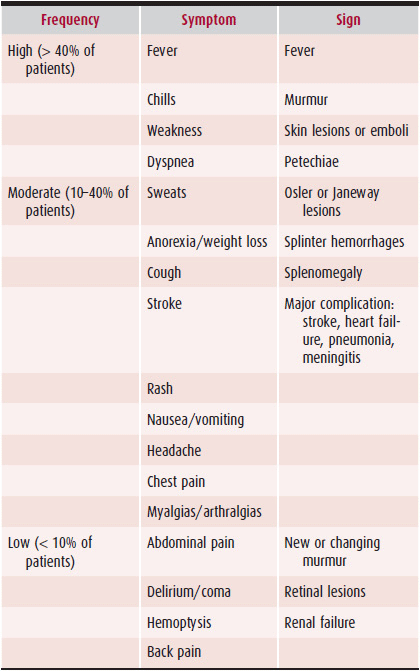
Stay updated, free articles. Join our Telegram channel

Full access? Get Clinical Tree


